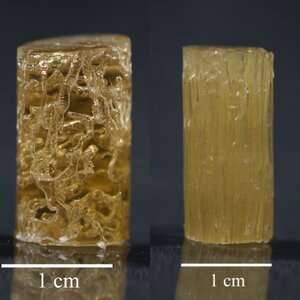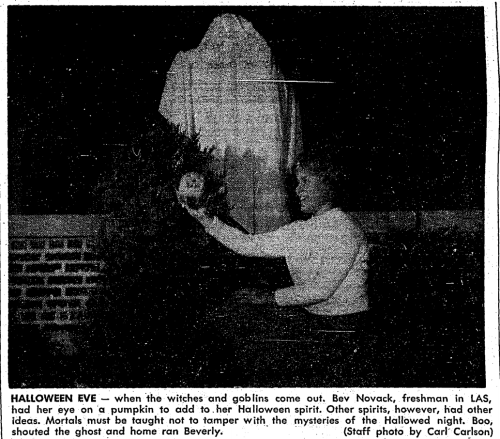#university of illinois
Search for new semiconductors heats up with gallium oxide
University of Illinois electrical engineers have cleared another hurdle in high-power semiconductor fabrication by adding the field’s hottest material – beta-gallium oxide – to their arsenal. Beta-gallium oxide is readily available and promises to convert power faster and more efficiently than today’s leading semiconductor materials – gallium nitride and silicon, the researchers said.
Their findings are published in the journal ACS Nano.
Flat transistors have become about as small as is physically possible, but researchers addressed this problem by going vertical. With a technique called metal-assisted chemical etching – or MacEtch – U. of I. engineers used a chemical solution to etch semiconductor into 3D fin structures. The fins increase the surface area on a chip, allowing for more transistors or current, and can therefore handle more power while keeping the chip’s footprint the same size.
Developed at the U. of I., the MacEtch method is superior to traditional “dry” etching techniques because it is far less damaging to delicate semiconductor surfaces, such as beta-gallium oxide, researchers said.
“Gallium oxide has a wider energy gap in which electrons can move freely,” said the study’s lead author Xiuling Li, a professor of electrical and computer engineering. “This energy gap needs to be large for electronics with higher voltages and even low-voltage ones with fast switching frequencies, so we are very interested in this type of material for use in modern devices. However, it has a more complex crystal structure than pure silicon, making it difficult to control during the etching process.”
Study identifies trace metals in propellant, reports method to mitigate decomposition
A salt used to create a green rocket fuel is known to decompose metals—such as those in metal propellant storage tanks. Recent research at the University of Illinois Urbana-Champaign found that there are also trace metals in the fuel itself and investigated a way to slow the decomposition using compounds that bind to metals.
“We knew from previous studies that metals work as a catalyst for decomposition in hydroxylammonium nitrate—a flight-proven monopropellant that you don’t have to wear a HAZMAT suit around—but we didn’t know the rate it decomposes, particularly when it’s exposed to heat,” said Emil Broemmelsiek, a Ph.D. student in the Department of Aerospace Engineering at UIUC. “The study I did focused on atmospheric pressure, so more like storage conditions. Over time, HAN in storage can dissolve the steel tank, which contains enough iron to catalyze the decomposition process.
"In the HAN samples from the manufacturer, we found trace amounts of metals—about a part-per-million level—but even those trace impurities have a catalytic effect. In this study, I checked the temperature at which it decomposes and how fast it decomposes. Then I used additives to see if they could be used to remove the metals. And it worked.”
Post link
Bioinspired veins provide structure, transport fluids in foamed polymers
Many lessons learned in life are learned from trees. Stand firm. Good things take time. Bend, don’t break. But metaphors aside, our stately arboreal neighbors offer a wealth of scientific wisdom—and we have a lot to learn.
Simply by existing, trees are nature’s first materials scientists. Like many plants, they have vascular systems, networks of tube-like channels that transport water and other vital nutrients from root, to branch, to leaf.
A research team at the Beckman Institute for Advanced Science and Technology developed a chemical process to create foamed polymers with vascular systems of their own, controlling the direction and alignment of the hollow channels to provide structural support and efficiently move fluids through the material.
Their work, “Anisotropic foams via frontal polymerization,” was published in Advanced Materials.
Post link
Going cubic halves the efficiency droop in InGaAlN light-emitting diodes
Today, it is widely accepted that the large Auger coefficient is the main cause for the large (~50%) efficiency droop in traditional hexagonal-phase InGaAlN LEDs. Yet, this explanation is inadequate to account for the low efficiency droop in gallium arsenide- and gallium phosphide-based LEDs, as those have similar Auger coefficients.
InIEEE Transactions on Electron Devices, Can Bayram, Jean-Pierre Leburton and Yi-Chia Tsai at the University of Illinois at Urbana-Champaign show that the coexistence of strong internal polarization and large carrier effective mass accounts for ~51% of the efficiency droop under high current densities in hexagonal-phase green InGaAlN LEDs (h-LEDs) compared to cubic-phase InGaAlN green LEDs (c-LEDs).
Post link
Section #2 of Professor W.T. Eckley’s dissecting class, College of Physicians & Surgeons, 813 W Harrison St., 1898, Chicago
University of Illinois At Chicago Library of the Health Sciences University Archives
Post link
Today’s post comes from Violet Fox, who previously wrote ourpost about Henriette Avram. Violet is on Twitter at@violetbfox.
Margaret Mann (1873-1960) was a librarian and educator whose work and scholarship emphasized the role of theory in cataloging and classification. Her passion for information organization inspired the many students she taught to see cataloging and classification as an essential service to library users.
Born in Cedar Rapids, Iowa on April 9, 1873, as an adolescent Mann moved with her family to Chicago and graduated from Englewood High School. She enrolled at Chicago’s Armour Institute in 1893, as one of the first twelve students in the library program (the Armour Institute was only the fourth school for the education of librarians in the U.S. and the first west of the Alleghanies). There she studied preservation, cataloging, accessioning, and shelf-listing, as well as learning library hand. After graduating a year later, most of her cohort moved on to library jobs, but Mann was asked to stay on as an assistant at Armour, serving as a cataloger and occasional instructor. When the library science department was moved from Armour to the University of Illinois in 1897, Mann was appointed to the staff of the new program. While teaching at the University of Illinois, she also worked towards creating consistent policies of cataloging and classification within its library. Mann moved on to the Carnegie Library in Pittsburgh in 1902, serving as head of the Cataloging Department until 1919. From 1919 to 1924 she undertook a massive reorganization of the collections of the Library of the Engineering Societies in New York City.
After returning from teaching cataloging and classification at the École de Bibliothécaires in Paris in 1926, she began as an instructor at the University of Michigan as one of the first three faculty hired at the beginning of the school’s library science program. Unlike her own library school experience thirty years earlier, which was highly focused on everyday library practice, Mann’s publications and teaching focused on the need to understand the theory of cataloging and classification to serve library users well. Her textbook, “An Introduction to Cataloging and the Classification of Books,” first published in 1930 by ALA, was widely used by library schools and helped standardize the cataloging content taught to library students. She would remain at the University of Michigan until her retirement at age 65 in 1938, impressing upon her many students the important role of information organization in libraries.
Mann died in 1960 but her name and legend live on in the University of Michigan’s Margaret Mann Award, established in 1938, as well as in the Margaret Mann Citation, awarded yearly by ALA to recognize outstanding professional achievement in cataloging or classification. Mann was also listed within American Libraries’s 1999 article on “100 of the Most Important Leaders We Had in the 20th Century”.
Resources consulted:
Clack, Doris H. (1993). Education for Cataloging.Cataloging & Classification Quarterly, 16:3, 27-37, DOI: 10.1300/J104v16n03_04
Grotzinger, Laurel. (1970). Margaret Mann: The Preparatory Years.Journal of Education for Librarianship, 10:4, 302-315, DOI: 10.2307/40322089
University of Michigan Faculty History Project
Wikipedia biography of Margaret Mann
Name Rebecca Cordes Chan
Location Baltimore, MD, USA
What do you do? I am a Program Officer for the Local Initiative Support Corporation (LISC) National Creative Placemaking Program. Creative Placemaking can be a loaded term, but I think of it as resident-driven process that builds on existing cultural assets. I spend the majority of my time managing LISC’s Creative Placemaking Technical Assistance program. Through a partnership between The Kresge Foundation and The National Endowment for the Arts, the program is a pilot intended to provide the creative placemaking field a deeper understanding of how to do arts-based community development well. I am working on specialized technical assistance plans for 16 organizations with the goal of advancing each organization’s ability to lead successful projects that result in positive short- and long-term outcomes for their community. Prior to LISC, I was an arts-based community development practitioner as Station North’s Program Director, then later for a philanthropic organization as their Program Officer. I was named 10 people to watch under 30 by Baltimore Sun in 2014, and was selected to be part of the Baltimore Social Innovation Journal’s cohort the same year. I have an M.S. in Historic Preservation from University of Pennsylvania, and B.A. in Anthropology from the University of Illinois, Urbana-Champaign.
Share what you do. http://bit.ly/ADEsubmit.
Post link









![University of Illinois, 1956 [via]. University of Illinois, 1956 [via].](https://64.media.tumblr.com/tumblr_kr4eclp6jC1qa64fuo1_500.jpg)



